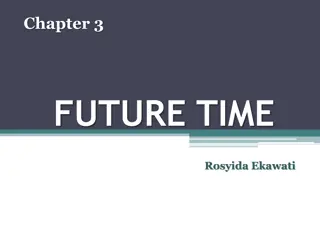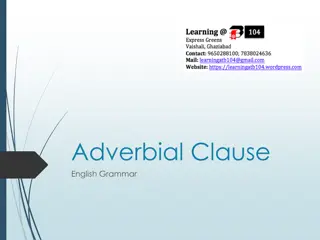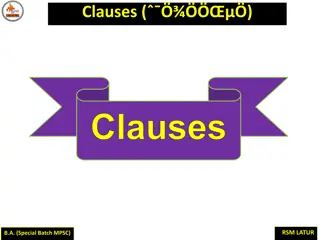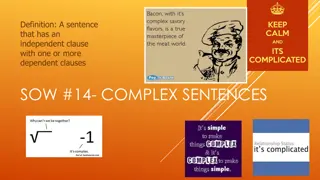Understanding Adjective Clauses in English Grammar
Adjective clauses, also known as relative clauses, are dependent clauses that act as adjectives in sentences. They modify nouns, pronouns, or entire sentences and begin with a relative pronoun. This article explains how adjective clauses function, provides examples, and discusses the use of pronouns within these clauses.
Download Presentation

Please find below an Image/Link to download the presentation.
The content on the website is provided AS IS for your information and personal use only. It may not be sold, licensed, or shared on other websites without obtaining consent from the author. Download presentation by click this link. If you encounter any issues during the download, it is possible that the publisher has removed the file from their server.
E N D
Presentation Transcript
Adjective Clauses An adjective (or relative) clause is a dependent clause that functions as an adjective in a sentence. It modifies nouns, pronouns, or a whole sentence. It begins with a relative pronoun. It comes immediately after the words that it modifies. In some cases, a prepositional phrase may come in between.
Adjective Clause Pronouns Used as the Subject I thanked the woman. She helped me. (a) I thanked the woman who helped me. (b) I thanked the woman that helped me. In (a): I thanked the woman = a main clause; who helped me = an adjective clause.* An adjective clause modifies a noun. In (a): the adjective clause modifies woman.
In (a): who is the subject of the adjective clause. In (b): that is the subject of the adjective clause. NOTE: (a) and (b) have the same meaning; (c) and (d) have the same meaning. The book is mine. It is on the table. (c) The book which is on the table is mine. (d) The book that is on the table is mine.
Who = used for people Which = used for things That = used for both people and things (e) CORRECT: The book that is on the table is mine. (f) INCORRECT: The book is mine that is on the table. An adjective clause closely follows the noun it modifies.
Exercise 3, p. 271. 2. The girl who/that won the race is happy. 3. The student who/that sits next to me is from China. 4. The students who/that sit in the front row are from China. 5. We are studying sentences that/which contain adjective clauses. 6. I am using a sentence that/which contains an adjective clause
Adjective Clause Pronouns Used as the Object of a Verb The man was Mr. Jones. I saw him. a) The man b) The man c) The man who(m) I saw was Mr. Jones. that I saw was Mr. Jones. I saw was Mr. Jones. Notice in the examples: The adjective clause pronouns are placed at the beginning of the clause. In (a): who is usually used instead of whom, especially in speaking. Whom is generally used only in very formal English.
The movie wasnt very good. We saw it last night. (d) The movie which we saw last night good. wasn t very (e) The movie that good. we saw last night wasn t very (f) The movie good. we saw last night wasn't very In (c) and (f): An object pronoun is often omitted ( ) from an adjective clause. (A subject pronoun, however, may not be omitted.)
who(m) = used for people which = used for things that = used for both people and things (g) INCORRECT: The man who(m) I saw him was Mr. Jones. The man that I saw him was Mr. Jones. The man I saw him was Mr. Jones. In (g): The pronoun him must be removed. It is unnecessary because who(m), that, or functions as the object of the verb saw.
Exercise 8, p. 273. 2. I liked the woman who/that/whom/ I met at the party last night. 3. I liked the composition that/which/ you wrote. 4. The people who/that/whom/ we visited yesterday were very nice. 5. The man who/that/whom/ Ann brought to the party is standing over there.
Adjective Clause Pronouns Used as the Object of a Preposition She is the woman. I told you about her. a) She is the woman about whom I told you. b) She is the woman who(m) I told you about. c) She is the woman that I told you about. d) She is the woman I told you about. In very formal English, the preposition comes at the beginning of the adjective clause, as in (a) and (e). Usually, however, in everyday usage, the preposition comes after the subject and verb of the adjective clause, as in the other examples.
The music was good. We listened to it last night. e) The music to which we listened last night was good. f) The music which we listened to last night was good. g) The music that we listened to last night was good. h) The music we listened to last night was good.
NOTE: If the preposition comes at the beginning of the adjective clause, only whom or which may be used. A preposition is never immediately followed by that or who. INCORRECT: She is the woman about who I told you. INCORRECT : The music to that we listened last night was good.
Exercise 11, p. 274. 1. The man who I was telling you about is standing over there. The man whom I was telling 5'ou about is standing over there. The man that I was telling you about is standing over there. The man I was telling you about is standing over there. The man about whom I was telling you is standing over there. 2. I must thank the people who I got a present from. I must thank the people whom I got a present from. I must thank the people that I got a present from. I must thank the people I got a present from. I must thank the people from whom I got a present. 3. The meeting that Omar went to was interesting. The meeting which Omar went to was interesting. The meeting Omar went to was interesting. The meeting to which Omar went was interesting.
Exercise 13, p. 275. 2. which I had borrowed from my roommate that I had borrowed from my roommate I had borrowed from my roommate 3. I hadn t seen for years who I hadn t seen for years whom I hadn t seen for years that I hadn t seen for years 4. she knew very little about which she knew very little about that she knew very little about about which she knew very little 5. who keeps chickens in his apartment that keeps chickens in his apartment
Exercise 14, p. 275. 1. In our village, there were many people who/that didn t have much money. 2. I enjoyed the book that you told me to read. 3. I still remember the man who taught me to play the guitar when I was a boy. 4. I showed my father a picture of the car I am going to buy as soon as I save enough money. 5. The woman about whom I was talking suddenly walked into the room, or The woman whom I was talking about suddenly walked into the room. I hope she didn t hear me. 6. The people who/that appear in the play are amateur actors. 7. I don t like to spend time with people who/that lose their temper easily. 8. While the boy was at the airport, he took pictures of people who/that were waiting for their planes. 9. People who work in the hunger program estimate that 45,000 people worldwide die from starvation and malnutrition-related diseases every single day of the year. 10. In one corner of the marketplace, an old man was playing a violin.
Subject vs. Object Relative Pronouns If the relative pronoun is followed by a verb, it is a subject pronoun. In this case, the relative pronoun must be used. For example: I ate the apple which is lying on the table. If the relative pronoun is not followed by a verb (i.e., by a noun or a pronoun), it is an object pronoun. In restrictive relative clauses, it may be omitted. For example: I ate the apple which Sara put on the table OR I ate the apple Sara put on the table.
Using Whose I know the man. His bicycle was stolen. (a) I know the man whose bicycle was stolen. The student writes well. I read her composition. (b) The student whose composition I read writes well.
Whose is used to show possession. It carries the same meaning as other possessive pronouns used as adjectives: his, her, its, and their. Like his, her, its, and their, whose is connected to a noun: his bicycle > whose bicycle her composition --> whose composition Both whose and the noun it is connected to are placed at the beginning of the adjective clause. Whose cannot be omitted.
(c) I worked at a company whose employees wanted to form a union. Whose usually modifies people, but it may also be used to modify things, as in (c).
(d) That's the boy whose parents you met. (e) That s the boy who s in my math class. ( f ) That s the boy who s been living at our house since his mother was arrested.* Whose and who s have the same pronunciation. Who's can mean who is, as in (e), or who has, as in (f). *When has is a helping verb in the present perfect, it is usually contracted with who in speaking and sometimes in informal writing, as in ( f ) i.e. who s. When has is a main verb, it is not contracted with who: I know a man who has a cook.
Exercise 18, p. 278. 2. Mrs. North teaches a class for students whose native language is not English. 3. The people whose house we visited were nice. 4. I live in a dormitory whose residents come from many countries. 5. I have to call the man whose umbrella I accidentally picked up after the meeting. 6. The man whose beard caught on fire when he lit a cigarette poured a glass of water on his face.
Using Where in Adjective Clauses The building is very old. He lives there (in that building). (a) The building where he lives is very old. (b) The building in which he lives is very old. The building which he lives in is very old. The building that he lives in is very old. The building he lives in is very old.
Where is used in an adjective clause to modify a place (city, country, room, house, etc.). If where is used, a preposition is NOT included in the adjective clause, as in (a). If where is not used, the preposition must be included, as in (b).
Exercise 24, p. 280. 1. The city where we spent our vacation was beautiful. The city in which we spent our vacation was beautiful. The city which/that/ we spent our vacation in was beautiful. 2. That is the restaurant where I will meet you. That is the restaurant at which I will meet you. That is the restaurant which/that/ I will meet you at. 3. The office where I work is busy. The office in which I work is busy. The office which/that/ I work in is busy. 4. That is the drawer where I keep my jewelry. That is the drawer in which I keep my jewelry. That is the drawer which/that/ I keep my jewelry in.
Using When in Adjective Clauses I ll never forget the day. I met you then (on that day). (a) I ll never forget the day when I met you. (b) I'll never forget the day on which I met you. (c) I ll never forget the day that I met you. (d) I ll never forget the day I met you.
When is used in an adjective clause to modify a noun of time (year, day, time, century, etc.). The use of a preposition in an adjective clause that modifies a noun of time is somewhat different from that in other adjective clauses: a preposition is used preceding which, as in (b); otherwise, the preposition is omitted.
Exercise 26, p. 280. 1. Monday is the day when they will come. Monday is the day on which they will come. Monday is the day that/ they will come. 2. 7:05 is the time when my plane arrives. 7:05 is the time at which my plane arrives. 7:05 is the time that/ my plane arrives. 3. 1960 is the year when the revolution took place. 1960 is the year in which the revolution took place. 1960 is the year that/ the revolution took place. 4. July is the month when the weather is usually the hottest. July is the month in which the weather is usually the hottest. July is the month that/ the weather is usually the hottest.
Exercise 27, p. 281. 3. A cafe is a small restaurant where people can get a light meal. 4. Every neighborhood in Brussels has small cafes where customers drink coffee and eat pastries. 5. There was a time when dinosaurs dominated the earth. 6. The house where I was born and grew up was destroyed in an earthquake ten years ago. 7. The miser hid his money in a place where it was safe from robbers. 8. There came a time when the miser had to spend his money.
Using Adjective Clauses to Modify Pronouns (a) There is someone I want you to meet. (b) Everything he said was pure nonsense. (c) Anybody who wants to come is welcome. Adjective clauses can modify indefinite pronouns (e.g., someone, everybody). Object pronouns (e.g., who(m), that, which) are usually omitted in the adjective clause, as in (a) and (b).
(d) Paula was the only one I knew at the party. (e) Scholarships are available for those who need financial assistance. Adjective clauses can modify the one(s) and those* *An adjective clause with which can also be used to modify the demonstrative pronoun that: We sometimes fear that which we do not understand. The bread my mother makes is much better than that which you can buy at a store.
(f) INCORRECT: I who am a student at this school come from a country in Asia. Adjective clauses are almost never used to modify personal pronouns. Native English speakers would not write the sentence in (f).
(g) It is I who am responsible. (h) He who laughs last laughs best. Example (g) is possible, but very formal and uncommon. Example (h) is a well-known saying in which he is used as an indefinite pronoun (meaning anyone or any person ).
Punctuating Adjective Clauses General guidelines for the punctuation of adjective clauses: (1) Do not use commas if the adjective clause is necessary to identify the noun it modifies.* *Adjective clauses that do not require commas are called essential or restrictive or identifying. (1) Use commas if the adjective clause simply gives additional information and is not necessary to identify the noun it modifies.** **Adjective clauses that require commas are called nonessential or nonrestrictive or nonidentifying. NOTE: Nonessential adjective clauses are more common in writing than in speaking.
(a) The professor who teaches Chemistry 101 is an excellent lecturer. (b) Professor Wilson, who teaches Chemistry 101, is an excellent lecturer. In (a): No commas are used. The adjective clause is necessary to identify which professor is meant. In (b): Commas are used. The adjective clause is not necessary to identify Professor Wilson. We already know who he is: he has a name. The adjective clause simply gives additional information.
(c) Hawaii, which consists of eight principal islands, is a favorite vacation spot. (d) Mrs. Smith, who is a retired teacher, does volunteer work at the hospital. GUIDELINE: Use commas, as in (b), (c), and (d), if an adjective clause modifies a proper noun. (A proper noun begins with a capital letter.) NOTE: A comma reflects a pause in speech.
Who(m) (e) The man that / met teaches chemistry. (f) Mr. Lee, whom I met yesterday, teaches chemistry. In (e): If no commas are used, any possible pronoun may be used in the adjective clause. Object pronouns may be omitted. In (f): When commas are necessary, the pronoun that may not be used (only who, whom, which, whose, where, and when may be used), and object pronouns cannot be omitted.
COMPARE THE MEANING: (g) We took some children on a picnic. The children, who wanted to play soccer, ran to an open field as soon as we arrived at the park. (h) We took some children on a picnic. The children who wanted to play soccer ran to an open field as soon as we arrived at the park. The others played a different game. In (g): The use of commas means that all of the children wanted to play soccer and all of the children ran to an open field. The adjective clause is used only to give additional information about the children. In (h): The lack of commas means that only some of the children wanted to play soccer. The adjective clause is used to identify which children ran to the open field.
Exercise 35, p. 286. 3. additional: Rice, which is grown in many countries, is a staple food throughout much of the world. 4. necessary: The rice which we had for dinner last night was very good. 5. necessary: The newspaper article was about a man who died two weeks ago of a rare tropical disease. 6. additional: Paul O Grady, who died two weeks ago of a sudden heart attack, was a kind and loving man. 7. additional: I have fond memories of my hometown, which is situated in a valley. 8. necessary: I live in a town which is situated in a valley. 9. necessary: People who live in glass houses shouldn t throw stones. 10. additional: In a children s story, Little Red Riding Hood, who went out one day to visit her grandmother, found a wolf in her grandmother s bed when she got there.
Exercise 37, p. 287. 3. The Mississippi River, which flows south from Minnesota to the Gulf of Mexico, is the major commercial river in the United States. 4. A river that is polluted is not safe for swimming. (no commas) 5. Mr. Trang, whose son won the spelling contest, is very proud of his son s achievement. The man whose daughter won the science contest is also very pleased and proud. 6. Goats, which were first tamed more than 9,000 years ago in Asia, have provided people with milk, meat, and wool since prehistoric times. 7. She s furious at the goat that got on the wrong side of the fence and is eating her flowers. (no commas)
Exercise 40, p. 288. 1. (no change) 2 . We enjoyed Mexico City, where we spent our vacation. 3. (no change) 4. One of the most useful materials in the world is glass, which is made chiefly from sand, soda, and lime. 5. You don t need to take heavy clothes when you go to Bangkok, which has one of the highest average temperatures of any city in the world. 6. Child labor was a social problem in late eighteenth century England, where employment in factories became virtual slavery for children. 7. (no change) 8. (1st sentence: no change) The research scientist, who was wearing protective clothing before she stepped into the special chamber holding the bees, was not stung. (3rd sentence: no change)
Exercise 43, p. 290. 2. Last night the orchestra played three symphonies, one of which was Beethoven s Seventh. 3. I tried on six pairs of shoes, none of which I liked. 4. The village has around 200 people, the majority of whom are farmers. 5. That company currently has five employees, all of whom are computer experts. 6. After the riot, over 100 people were taken to the hospital, many of whom had been innocent bystanders.
Using Expressions of Quantity in Adjective Clauses In my class there are 20 students. Most of them are from Asia. (a) In my class there are 20 students, most of whom are from Asia. (b) He gave several reasons, only a few of which were valid. (c) The teachers discussed Jim, one of whose problems was poor study habits. An adjective clause may contain an expression of quantity with of: some of, many of, most of, none of, two, of, half of, both of, etc. The expression of quantity precedes the pronoun. Only whom, which, and whose are used in this pattern. This pattern is more common in writing than speaking. Commas are used.
Using Which to Modify a Whole Sentence a) Tom was late. That surprised me. (b) Tom was late, which surprised me. (c) The elevator is out of order. This is too bad. (d) The elevator is out of order, which is too bad. The pronouns that and this can refer to the idea of a whole sentence which comes before. In (a): The word that refers to the whole sentence Tom was late. Similarly, an adjective clause with which may modify the idea of a whole sentence. In (b): The word which refers to the whole sentence Tom was late.
Using which to modify a whole sentence is informal and occurs most frequently in spoken English. This structure is generally not appropriate in formal writing. Whenever it is written, however, it is preceded by a comma to reflect a pause in speech
Exercise 46, p. 292. 2. She usually came to work late, which upset her boss. 3. So her boss fired her, which made her angry. 4. She hadn t saved any money, which was unfortunate. 5. So she had to borrow some money from me, which I didn t like. 6. She has found a new job, which is lucky. 7. So she has repaid the money she borrowed from me, which I appreciate. 8. She has promised herself to be on time to work every day, which is a good idea.
Exercise 47, p. 292. 2. The blue whale, which can grow to 100 feet and 150 tons, is considered the largest animal that has ever lived. 3. The plane was met by a crowd of 300 people, some of whom had been waiting for more than four hours. 4. In this paper, I will describe the basic process by which raw cotton becomes cotton thread. 5. The researchers are doing case studies of people whose families have a history of high blood pressure and heart disease to determine the importance of heredity in health and longevity.
6. At the end of this month, scientists at the institute will conclude their AIDS research, the results of which will be published within six months. 7. According to many education officials, math phobia (that is, fear of mathematics) is a widespread problem to which a solution can and must be found. 8. The art museum hopes to hire a new administrator under whose direction it will be able to purchase significant pieces of art. 9. The giant anteater, whose tongue is longer than 30 centimeters (12 inches'), licks up ants for its dinner. 10. The anteater s tongue, which can go in and out of its mouth 160 times a minute, is sticky.























